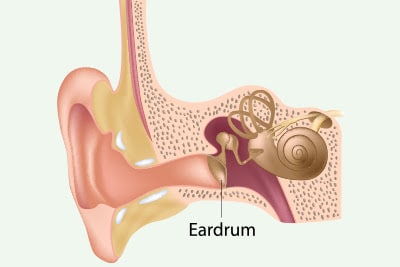Published on May 7th, 2021 and Updated on February 7th, 2024
Check out SneakPeek Gender Test to find out your baby’s gender as early as 6 weeks at over 99% accuracy1!

Even before your baby can speak, you’ll start to understand his language. You’ll learn that lifting his arms means he wants to be held, bouncing up and down means he’s feeling the beat, and scrunching his face means, well, a diaper change is in your future.
There’s also a possibility you’ll learn that tugging at his ears, crying more than normal, and refusing to eat means he’s suffering from an ear infection—the most common reason parents take their children to the doctor. What causes ear infections in babies?
The culprit behind baby ear infections is blocked eustachian tubes—tiny pipes made of bone and cartilage that connect your baby’s middle ear to his upper throat. If this answer has you scrunching your face (in confusion, that is), don’t worry—we’re here to translate.
What is an ear infection?
An ear infection occurs when fluid builds up behind the tympanic membrane—a thin collection of connective tissues covered in skin. You probably know this membrane as the eardrum. When built up fluid is trapped behind the eardrum, it can become home to unwanted bacteria.
Where does this mysterious ear fluid come from? How does it build up?
To answer these questions, we need to take a Magic School Bus-esque journey into our ears to better understand how they work. Grab a pencil, buckle your seatbelt, and let’s dive in.
Listen to This: The Science of Hearing
Our ears are composed of three main parts—the outer ear, the middle ear, and the inner ear.
- The outer ear, also known as the pinna, encompasses all the outside parts of the ear you can see ,as well as the ear canal. The outer ear stops at the eardrum, which separates the outer ear from the middle ear.
- The middle ear houses the malleus, incus, and stapes. No, these aren’t new Teletubbies. They’re three tiny bones (smaller than your baby’s little earlobe!) that work together to transmit sound from the outer ear to the inner ear.
Sound transmission starts when sonic vibrations hit the eardrum, which is directly connected to the malleus (also known as the hammer). Once the hammer feels those good vibrations, it hits the incus (commonly referred to as the anvil). The anvil then sends these vibrations to the last bone—the stapes, or stirrup. The stapes uses its vibrational force to stir-up the fenestra ovalis—a thin membrane also known as the oval window which marks the start of the inner ear.
(Don’t worry, we’re almost to the fluid.)
By tapping on this oval window, the stapes sends vibrations through the inner ear to the cochlea. This magical organ is responsible for converting sound vibrations into electrical signals. These signals then travel through the auditory nerve to the brain where they’re analyzed and interpreted. It’s how your baby recognizes the jingle of his favorite toy, or the soothing sound of your voice.
During this chain of events, the middle ear will secrete fluid that acts as a line of defense against bacteria. When this fluid drains out of the middle ear through the eustachian tubes, it takes the unwanted bacteria along for the ride.
Despite still learning the logistics of walking and talking, your baby’s body is capable of a lot of complex activity!
However, when your baby develops a cold, sore throat, or upper respiratory infection, the eustachian tubes can become inflamed and swollen. That means the fluid in the middle ear can’t drain. Instead, it builds up against the eardrum, causing the perfect environment for unwanted bacteria and thus, an ear infection.
Types of Ear Infections
For babies and adults alike, there are the three main types of ear infections:
- Acute otitis media – The most common type of ear infection, acute otitis media is anything but cute. This infection causes the middle ear to become inflamed and swollen, trapping fluid behind the eardrum where it too becomes infected.
- Otitis media with effusion – Otitis media with effusion can often evade parents since many children show no symptoms. It occurs when fluid stays trapped behind your child’s eardrum even after the initial acute otitis media has run its course.
- Chronic otitis media with effusion – Aptly termed chronic, this type of infection occurs when there is fluid buildup within the ear time and time again. If you find your baby is consistently suffering from ear infections, it may be a sign of a genetic predisposition (but more on that later).
Why are ear infections common in infants?
Ear infections are exceptionally common in newborns. In fact, 5 out of 6 children will have had at least one ear infection by the time they turn 3 (worst birthday present ever).
Reasons why ear infections happen to babies so often:
#1 Babies Have A Brand-New Immune System That’s More Prone to Infections
When a baby is in Mom’s womb, she is protected from infections, and once she’s born, her immune system is starting from scratch. This makes her much more susceptible to catching a cold that can cause her eustachian tubes to inflame and swell.
#2 Babies Have Tiny Everything (Including Eustachian Tubes)
From little fingers to tiny toes, everything about your baby is adorably-sized—even her eustachian tubes. And while bite-sized toes never hurt anyone (unless melting your heart counts), tiny eustachian tubes can. Due to the tiny size of baby eustachian tubes, any amount of inflammation can lead to a total blockage of the tube.
Those smaller parts also mean that bacteria have less distance to travel compared to an adult’s ear anatomy. Bacteria from a cold (or bacteria that enters the mouth) can use these tubes as fast-track tunnels to reach your baby’s middle ear and cause infection.
#3 Baby Tubes Provide A Level Playing Field for Bacteria
In addition to being smaller, baby eustachian tubes are also more level than adult eustachian tubes, sloping downward at a mere 10 degrees, rather than the 35 degrees seen in adults. This means that fluid that would normally easily drain out of an adult’s ear has a harder time draining from a baby’s. The process of draining baby eustachian tubes is a little like trying to pour liquid from a horizontal bottle. You and your baby both know this isn’t an efficient way for it to empty.
Take heart, as your baby grows and her face elongates, her eustachian tubes will follow suit.
Tips for Preventing, Treating, and Soothing Baby Ear Infections
When it comes to keeping those tiny tubes from tightening, preventing inflammation is key. While you can’t put your baby back into the protective bubble of your womb, you can consider the following preventative steps:
- Practice proper hygiene – Keeping your baby’s hands clean (along with his toys, blankets, and whatever else he manages to sneak into his mouth) can significantly reduce the risk of catching a cold or virus that can inflame his eustachian tubes.
- Ask your child’s doctor about an annual flu shot – If your baby is over six months old, he can receive an annual flu shot to protect him from the virus that causes the flu. This in turn can protect him from developing illnesses that lead to ear infection.
- Steer clear of smoke exposure – Studies show that children exposed to second-hand smoke are two to three times more likely to develop ear infections. This is because smoke can irritate those eustachian tubes and cause inflammation.
- Avoid irritating allergens – Like smoke, allergens such as pollen, dust, and pet dander can inflame your baby’s eustachian tubes and cause an increased production of tube-blocking mucus.
- Feed at an upright position – If your baby drinks from his bottle while lying down, milk or formula can travel back through his eustachian tubes and into his middle ear, increasing his risk of infection. Why? Because bacteria loves the sugars in your baby’s milk or formula. Food in your baby’s ear is an invitation for potential infection.
Treating and Soothing Baby Ear Infections
At this stage in your child’s development, preventative measures aren’t a guarantee that your baby will never get an ear infection. There’s always a chance bacteria or viruses can trigger an infection. If an infection does occur, you may notice your baby:
- Tugging at her ears
- Crying more than usual
- Refusing to eat
- Ignoring sounds
- Stumbling or acting dizzy
- Having trouble sleeping
- Running a fever
For an accurate diagnosis and an effective treatment plan, it’s best to call your doctor when you first notice signs of an ear infection. Since about 60% of children naturally see improvements within 24 hours, your doctor may recommend waiting for the infection to resolve on its own.
In this case, you can help soothe your baby’s ear pain by:
- Holding a warm compress to your child’s ear to help loosen the congestion of fluids and improve drainage
- Elevating her head by placing a small pillow beneath her crib mattress to increase airflow and fluid drainage
- Using acetaminophen (if she’s over six months old)
- Offering plenty of fluids to keep her hydrated and encourage swallowing (which can help open the eustachian tube)
However, if your baby is six months old or younger, or if she’s experiencing severe symptoms, your doctor or child’s pediatrician will likely prescribe an antibiotic.
For babies who suffer from chronic otitis media with effusion (remember our microscopic journey?), a doctor may recommend myringotomy tubes. These tiny tubes act as backup for when eustachian tubes are blocked, ensuring fluid and bacteria can’t fester within the middle ear. For children with recurrent ear infections,the tubes are inserted during a quick outpatient procedure under general anesthesia, and fall out on their own after six to eighteen months. Check out other resources like how to prevent baby ear infections.
Understanding the intricate workings of a baby’s ear can shed light on the causes of common ear infections, which are often due to blocked eustachian tubes, inflammation, and the anatomical differences between infants and adults. Practicing preventive measures, recognizing the symptoms early, and seeking proper medical attention can effectively manage these infections, helping to ensure your child’s overall well-being and comfort.
Editorial Policy
At SneakPeek, our commitment is to provide accurate, up-to-date, and reliable information to empower our readers. Our content is thoroughly researched, reviewed by medical experts, and fact-checked to ensure its credibility. We prioritize the well-being and education of our readers, and our editorial policy adheres to the highest standards of integrity and accuracy in all our articles.
This post has been reviewed for accuracy by the following medical professional:
Katie Smith is a seasoned Certified Nurse Midwife and a nurturing mother to six children, offering a unique blend of professional expertise and personal experience. She is the founder of Birth Your Way Midwifery and Women’s Wellness Center in Bay County, Florida. Katie's comprehensive approach to care is informed by her hands-on experience in motherhood and her passion for empowering women through their birthing journey. Her dedication extends beyond her center as she actively engages in community wellness and family health education.
Sources:
- National Institute of Health. Ear Infections in Children. https://www.nidcd.nih.gov/health/ear-infections-children
- Medline Plus. Tympanic Membrane. https://medlineplus.gov/ency/imagepages/8993.htm#:~:text=The%20tympanic%20membrane%20is%20also,bones%20in%20the%20middle%20ear.
- Verywell Health. What Mucous Membranes Do in Your Body. https://www.verywellhealth.com/what-are-mucous-membranes-1191862
- Verywell Health. The Anatomy of the Eustachian Tube. https://www.verywellhealth.com/what-is-the-eustachian-tube-1192115
- What To Expect. Easing Ear Infections in Babies and Toddlers. https://www.whattoexpect.com/childrens-health-and-safety/childhood-ear-infections.aspx
- WebMD. Could Your Child Have an Ear Infection? https://www.webmd.com/cold-and-flu/ear-infection/features/child-ear-infection
- Medical News Today. Can you treat baby ear infection without antibiotics? https://www.medicalnewstoday.com/articles/322219#home-and-natural-remedies
- Healthline. Home Remedies for Your Baby’s Ear Infection. https://www.healthline.com/health/childrens-health/remedies-for-baby-ear-infection#_noHeaderPrefixedContent
- National Institute on Deafness and Other Communication Disorders. Ear Infections in Children. https://www.nidcd.nih.gov/health/ear-infections-children#:~:text=Anyone%20can%20get%20an%20ear,is%20otitis%20media%20(OM).







